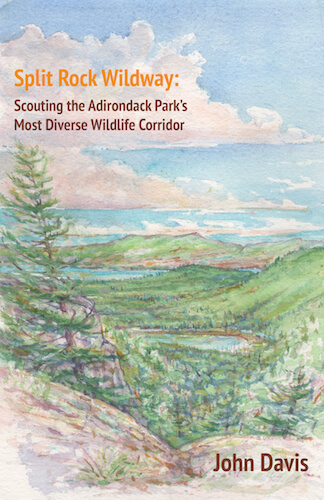
Anxiously awaiting more snow, in this taunting winter of 2018, I recently skied the only place I could, across the big wetland at Hemlock Rock Wildlife Sanctuary, then Microspiked up Adirondack Land Trust’s part of Coon Mountain. I was on protected land throughout this ramble in Split Rock Wildway, thanks to Adirondack Land Trust, Northeast Wilderness Trust, and Champlain Area Trails, and saw abundant tracks of many of our native mammals — the prints in the snow telling stories of the lives of our wild neighbors, hinting at their journeys through a winter wonderland.
Indeed, in a casual hour of tracking on a “random scoot” (to borrow the apt phrase of my Adirondack Park conservation mentor Gary Randorf), I saw spoor of at least six carnivore species, as many bird species, more rodent species, and abundant deer (the hungry herbivores perhaps unnaturally abundant — given our lack of top carnivores).

I saw the gingerly placed, symmetrical, four-toed prints of a Bobcat, prowling for rodents along the swamp and pond edges. I back-tracked the straight-line, big, symmetrical four-toed and clawed prints of a pair of Coyotes. (It’s kinder to follow wildlife tracks backward, lest they feel pursued.) I puzzled over a similarly straight and symmetrical but narrower straddled print-line, and finally decided it was Red Fox (as I tried to recall the lessons from master tracker Sue Morse, Keeping Track founder, on how to distinguish Red Fox from Gray Fox or small Coyote). I chuckled at the remarkably hand-like, five-fingered prints of a Raccoon, mischievously looking into everything, in his or her saunter across the frozen wetland. I dizzied at the busy, meandering three-track sets of a foraging Fisher, half way up then all over Coon’s rocky south slopes.
Returning to the wetland, I rejoiced to find River Otter slides radiating out from a hole in the ice. Other tracks showed the hole to be entry and exit point for many animals, including the wetland-making Beavers, and perhaps their smaller distant cousins: Muskrats. I’ve only seldom seen River Otter tracks in recent winters here in the eastern Adirondacks (maybe because increased fur prices are causing more trapping?), so I was especially grateful to see the tracks of this playful weasel family member.
My joy in seeing so many signs from my wild neighbors was somewhat dampened by recalling a human neighbor’s report from the previous week. This concerned resident had been upset to learn that the land manager of a nearby property was killing Bobcats, with guns or traps or both. My neighbor and I agreed: killing Bobcats is unkind and ecologically destructive. Then another neighbor added to my worries by telling my wife of four dead Coyotes she’d found shot and dumped on a nearby road.

For a farm family to use lethal means to defend its livestock is regrettable and avoidable (with good husbandry practices — see work of Wild Farm Alliance) but understandable. For the manager of an elite land-holding to kill top carnivores is unethical and unneighborly. For someone to wantonly shoot Coyotes and dump their carcasses off the side of the road is just plain sinful, in my view. As I urge in my book SPLIT ROCK WILDWAY: Scouting the Adirondack Park’s Most Diverse Wildlife Corridor, we need to learn to appreciate and protect our toothy neighbors, big and small.
So, head out to a wild forest or wetland and find some tracks. Back-track a mystery mammal for spell. Take a Keeping Track course, and consult tracking field guides (like ones by Sigurd Olson, Paul Rezendes, Mark Elbroch, or Sue Morse). Learn who is making which tracks. Then tell your neighbors, elected officials, land managers, and wildlife agencies how happy you are to share your homeland with the story-tellers in the snow.
Note: Special thanks to Sheri Amsel for permission to share her illustrations in this post.

 John Davis is a wildways scout, editor, and writer. He lives with his family in Split Rock Wildway, where he care-takes Hemlock Rock Wildlife Sanctuary when not roaming farther afield. He is a volunteer land steward for Eddy Foundation, which has secured and opened to the public about 3,000 acres in the eastern Adirondacks; a board member of Champlain Area Trails and other outdoor/wildlife organizations; a co-founder of Wildlands Network; and is the Executive Director of The Rewilding Institute. He is the editor of many conservation publications and author of
John Davis is a wildways scout, editor, and writer. He lives with his family in Split Rock Wildway, where he care-takes Hemlock Rock Wildlife Sanctuary when not roaming farther afield. He is a volunteer land steward for Eddy Foundation, which has secured and opened to the public about 3,000 acres in the eastern Adirondacks; a board member of Champlain Area Trails and other outdoor/wildlife organizations; a co-founder of Wildlands Network; and is the Executive Director of The Rewilding Institute. He is the editor of many conservation publications and author of
I was going through my late father’s files and found one relating to you. So deeply heartened to see you continuing to do the good work. Truly I hope all is well in your world John.
Wonderful post, John! Thanks for taking us with you. Your words transported me to so many joyful adventures we’ve enjoyed together, most recently tracking Springtails in the Split Rock Wildway and Lobo in the Gila. But your words also took me back to the days when my nephews were still young and fascinated with wild places, to muddy treks and snowy treks spent deciphering our wild neighbors’ stories via their fading footprints. Such excitement! And such nostalgia…
Very good you got your nephews out there, George! We need to find our successors in Wildways protection and Rewilding, and let the land inspire them. Thanks for your ongoing leadership in these vital realms. John D